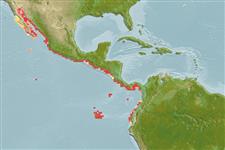Environment: milieu / climate zone / depth range / distribution range
Ecology
Marine; pelagic-neritic; depth range 0 - 50 m (Ref. 189). Tropical; 33°N - 3°S, 116°W - 77°W (Ref. 189)
Eastern Central Pacific: southwestern coast of Baja California, Mexico and the Gulf of California to Panama and the Galápagos Islands.
Size / Weight / Age
Maturity: Lm ? range ? - ? cm
Max length : 17.0 cm TL male/unsexed; (Ref. 114986); common length : 9.5 cm SL male/unsexed; (Ref. 9298)
Dorsal spines (total): 0; Anal spines: 0; Anal soft rays: 15 - 19. Body rather elongate, but somewhat compressed. Snout moderate, about 3/4 eye diameter; maxilla moderate, tip narrowly pointed, reaching onto sub-operculum, but not to edge of gill cover; gill cover canals of panamensis-type. Anal fin short, its origin below posterior third of dorsal fin base. A narrow silver stripe along flank, deeper above anal fin (about 3/4 to 2/3 eye diameter).
A schooling species occurring in coastal waters. Pelagic. Frequently caught over sand or gravel in the Gulf of Nicoya, Costa Rica, but also over mud.
Life cycle and mating behavior
Maturity | Reproduction | Spawning | Eggs | Fecundity | Larvae
May spawn throughout the year in the Gulf of Nicoya, Costa Rica (Ref. 189). Spawn in school (Ref. 205).
Whitehead, P.J.P., G.J. Nelson and T. Wongratana, 1988. FAO Species Catalogue. Vol. 7. Clupeoid fishes of the world (Suborder Clupeoidei). An annotated and illustrated catalogue of the herrings, sardines, pilchards, sprats, shads, anchovies and wolf-herrings. FAO Fish. Synop. 125(7/2):305-579. Rome: FAO. (Ref. 189)
IUCN Red List Status (Ref. 130435: Version 2024-1)
Threat to humans
Harmless
Human uses
Fisheries: subsistence fisheries
Tools
Special reports
Download XML
Internet sources
Estimates based on models
Preferred temperature (Ref.
123201): 20.6 - 28.5, mean 25.8 °C (based on 60 cells).
Phylogenetic diversity index (Ref.
82804): PD
50 = 0.5000 [Uniqueness, from 0.5 = low to 2.0 = high].
Bayesian length-weight: a=0.00589 (0.00355 - 0.00976), b=3.13 (2.99 - 3.27), in cm total length, based on LWR estimates for this species & Genus-body shape (Ref.
93245).
Trophic level (Ref.
69278): 3.4 ±0.4 se; based on size and trophs of closest relatives
Resilience (Ref.
120179): High, minimum population doubling time less than 15 months (Preliminary K or Fecundity.).
Fishing Vulnerability (Ref.
59153): Low vulnerability (10 of 100).
